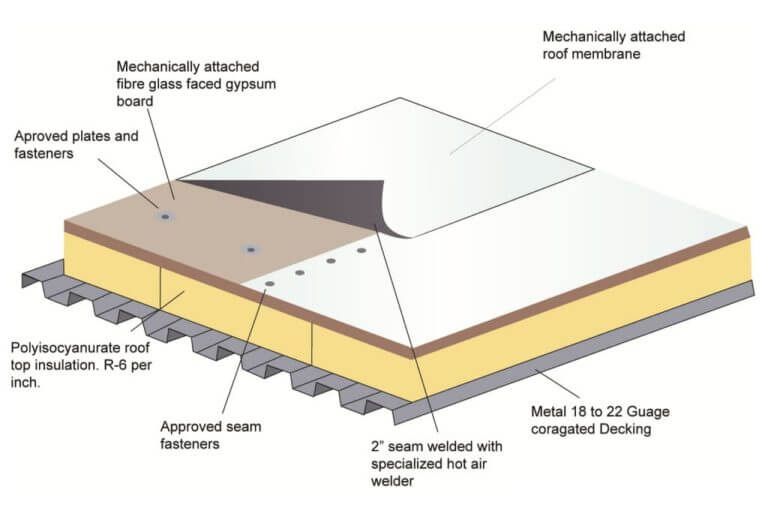Single-Ply Roofing Systems: An In-Depth Guide
Single-Ply Roofing Systems: An In-Depth Guide
Single-ply roofing systems are increasingly popular in commercial construction due to their durability, energy efficiency, and ease of installation. Comprising flexible sheets made from synthetic rubber or thermoplastic materials, single-ply roofs offer several advantages, making them a top choice for various commercial applications.
Types of Single-Ply Roofing SystemsThermoplastic Polyolefin (TPO) Roofing
TPO roofing has quickly become one of the most preferred choices in commercial roofing due to its combination of affordability, durability, and reflective properties.
Composition: Made from polypropylene and ethylene-propylene rubber.
Benefits: Exceptional resistance to UV rays, ozone, chemicals, and punctures. Highly reflective surface reduces heat absorption, enhancing energy efficiency.
Installation: Typically heat-welded, providing strong, watertight seams.
Polyvinyl Chloride (PVC) Roofing
PVC roofing is ideal for environments that demand chemical resistance and fire safety.
Composition: Composed of two layers of PVC reinforced with polyester.
Benefits: Superior resistance to chemical exposure, grease, and oils. Highly durable, fire-resistant, and reflective.
Installation: Heat-welded seams that create a continuous, waterproof membrane.
Ethylene Propylene Diene Monomer (EPDM) Roofing
EPDM is well-known for its durability and affordability, offering reliable performance for various commercial settings.
Composition: Made from synthetic rubber, typically black in color, but also available in reflective white.
Benefits: Highly durable, flexible, and resistant to weather extremes, including temperature fluctuations and ultraviolet rays.
Installation: Can be adhered fully, mechanically attached, or ballasted, depending on project requirements.
Advantages of Single-Ply Roofing
Ease of Installation: Quick and straightforward, reducing labor costs and minimizing operational downtime.
Cost-Effectiveness: Competitive initial costs combined with low long-term maintenance expenses.
Energy Efficiency: Reflective surfaces help lower heating and cooling costs, promoting sustainability.
Durability: Resistant to UV exposure, weather extremes, punctures, and chemicals.
Maintenance of Single-Ply Roofing Systems
Proper maintenance ensures the longevity and effectiveness of single-ply roofing systems:
Regular Inspections: Conduct periodic assessments to detect minor damages and address them promptly.
Cleaning: Remove debris and maintain drainage systems to prevent water pooling and potential membrane damage.
Immediate Repairs: Promptly address punctures, tears, or seam separations to maintain waterproof integrity.
Selecting the Right Single-Ply System
Factors to consider when choosing a single-ply system include:
Climate: Assess regional weather patterns and temperature extremes to select the best material.
Building Usage: Evaluate exposure to chemicals, grease, and fire hazards to determine optimal roofing.
Budget Constraints: Balance upfront costs against long-term benefits and maintenance expenses.
Conclusion
Single-ply roofing systems offer an efficient, durable, and cost-effective solution for commercial properties. Understanding the characteristics, benefits, and maintenance requirements of TPO, PVC, and EPDM roofing helps property owners and managers make informed decisions, ensuring long-term building protection and enhanced operational efficiency.
Be sure to check out our article about every kind of commercial roofing here: Commercial Roofing Systems Overview: A Comprehensive Guide - Roofing Tools Online

